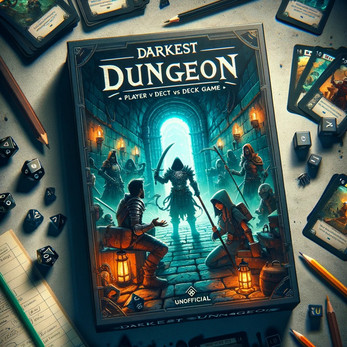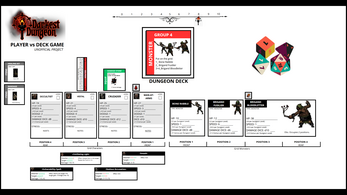Darkest Dungeon | Player vs Deck Game [Unofficial]
A downloadable game
In the depths of the unknown, where darkness lurks with voracious hunger, brave adventurers challenge the limits of sanity and survival. Each step is a risk, every shadow may hide an indescribable terror. Here, amidst the whispers of death and the echo of ancestral afflictions, the true battle is against one's own fear. Prepare to explore, fight, and perhaps succumb to the darkness that awaits in the player vs. deck version of "Darkest Dungeon."
GAME OBJECTIVE:
Assemble a team of adventurers, explore, and defeat the dangers of each dungeon. The game ends upon defeating the five Bosses of the deck.
PREPATATION:
- The player will need d4, d6, d8, d10, d12, and d20 dice, pencils, erasers, and paper for note-taking.
- The player places the grid of monsters in front of their own grid, chooses 4 characters, and places them on their side of the grid. The remaining characters are available to replace any deaths at the end of the expedition.
- Each character has seven abilities. The player must choose four of them to use in a dungeon and cannot change them during the expedition.
- Before entering the dungeon, the character can buy items from the items and equipment deck. Reveal five cards from the item pile and five cards from the equipment pile to set up the shop. The shopping deck should not contain items of a level higher than the characters. Each character starts with 2 coins. Item cards have no inventory limits. Each character can use 2 different equipment cards.
DUNGEON CREATION:
- The dungeon is a stack of cards facing downwards, representing the locations explored by the characters. Each dungeon level has a predetermined number of cards and a boss. The cards may contain monsters, empty rooms, treasures, or traps.
- The dungeon is set up as follows: Level 1/2/3/4/5: Shuffle 3/4/5/6/7 empty room cards, 3/4/5/6/7 treasure cards (choose treasures compatible with the dungeon level), 3/4/5/6/7 trap cards, and 9/12/15/18/21 monster cards. Draw the top 10/12/14/18/22 cards and cut the stack in half. Take one of the halves, remove the top card, place 1 boss card, and shuffle this half. Place this half with the boss underneath the other half.
EXPLORATION:
- Each face-down card represents a new area explored within the dungeon.
- Torch: Upon entering a dungeon, players light the Torch, which starts with a brightness of 10. Each new card revealed decreases the brightness by -1. The darker it gets, the greater the dangers, but also the greater the rewards. Pay attention to the markers on the Torch representing bonuses and penalties.
- Stress: The horrors of darkness leave deep traumas. If a character accumulates 10 Stress points, they acquire an Affliction or Virtue that persists until the end of the dungeon, even if their Stress subsequently decreases. If Stress reaches 20, the character suffers a heart attack and dies instantly. For each -1 decrease in Torch brightness, Stress increases by +1. There are also other sources of effects that cause Stress.
- Each revealed card triggers its described effect and counts as "one round" for various effects seen later. The "monster" card initiates combat.
COMBAT TURNS:
- At the start of combat, the Speed of units determines the order of rounds, and use markers to facilitate. In the event of a tie between a player character and a monster, the player goes first. In the case of a tie between units on the same side of the grid, the unit furthest forward goes first. After everyone has completed their rounds, the turn comes to an end. At the start of the next turn, if the Speed of participants has been altered, reorder the rounds.
- The player can choose between using an ability or moving their character, exchanging their position with an adjacent one. Monsters act according to their described artificial intelligence.
- On ability cards, "Attacker" and "Targets" represent, respectively, the positions from which attackers can execute their abilities and the positioning of targets that can be affected by them. An X means that the ability cannot be executed from that position or that the target in that position is not valid. A V represents that the position and target are valid. Two or more Vs linked by a dash mean that the ability affects both positions.
- If there is only one enemy in one of the squares, the ability only affects that enemy. Whenever a character or monster in a square further forward is defeated, all others move one square forward, with the last positions becoming prohibited.
- Damage: Hit and damage rolls are simplified. The attacker rolls their damage die. If the die result falls within the damage range of the ability, they hit and can cause that damage - altered by all bonuses and penalties - to the target.
- Bonuses and penalties applied to damage are always calculated after the basic damage result of the ability. Partial calculation results never go below 0. The final damage result is never less than 1.
- Dodge: If the monster successfully lands a hit, the target is entitled to a dodge roll. Each dodge number represents an individual number on the D20 chosen to represent a success. The defender rolls 1D20 and, if they roll one of the selected numbers, they dodge, taking no damage. Then, the attacker's round ends.
- Death's Door: Before losing the last HP point, the player character rolls 1d10. A result of 5 or more allows the character to remain alive with 1 HP, but it causes all allies to receive +1 Stress.
MONSTERS:
- Monsters have attributes similar to characters; however, each monster has only two randomly chosen abilities and does not dodge. Roll a d4: on a result of 1-2, it uses ability 1; on a result of 3-4, it uses ability 2. The boss has four abilities; each result on the d4 represents the use of one of them. The target of the abilities is chosen randomly, with the player assigning numbers to represent each target and rolling a die. Some monsters have larger sizes and special abilities.
- If a monster attempts to use an ability but is not positioned correctly or does not have a valid target, it will attempt to use the next ability on its list. If none of the abilities can be used, it will use its turn to move to a position where it can use at least one of its abilities on a valid target in its next round. If this is impossible, it passes its turn without acting. Monsters follow the same combat rules as characters; therefore, if a monster dies, it is removed from the board, and all other living monsters move 1 position forward. Monsters do not roll for Death's Door.
COMBAT RESOLUTION:
- Skills with numerical effects work until the end of the combat. Stress reduction, HP recovery, and Torch alterations are permanent.
END OF EXPEDITION:
- At the end of the dungeon, characters heal all statuses, level up, and share acquired treasures. Dead characters can be replaced by any available living ones.
- A new dungeon is assembled with a larger number of cards and a new boss. A new preparation is made.
- The goal of the game is to conquer the 5th dungeon, also known as the Darkest Dungeon.
| Status | Prototype |
| Category | Physical game |
| Rating | Rated 1.0 out of 5 stars (1 total ratings) |
| Author | Panda Storm |
| Genre | Adventure, Strategy |
| Tags | Board Game, darkest-dungeon, Dice, Fantasy, Horror, Multiplayer, Print & Play, Singleplayer |
| Average session | A few seconds |
Download
Click download now to get access to the following files:


Comments
Log in with itch.io to leave a comment.
the cover says "player v dect vs deck game" btw
machine generated images :(
Oh well. The picture and the game still looks cool though. Haven't tried it but still :)
hey dude, I found your comment on Confusing Lands about it being unavailable as a PNP. Luckily, I still have my copy of files from the time it was available. I didn't wanna be disrespectful to the designer's face by replying to your comment there, so here's a link to it and hope you enjoy! [https://drive.google.com/drive/folders/1kWAjnW6IqGHOfB6831bsh73oUSCoe6f1?usp=sha...]